情景对话练习总结
- 格式:doc
- 大小:292.50 KB
- 文档页数:6
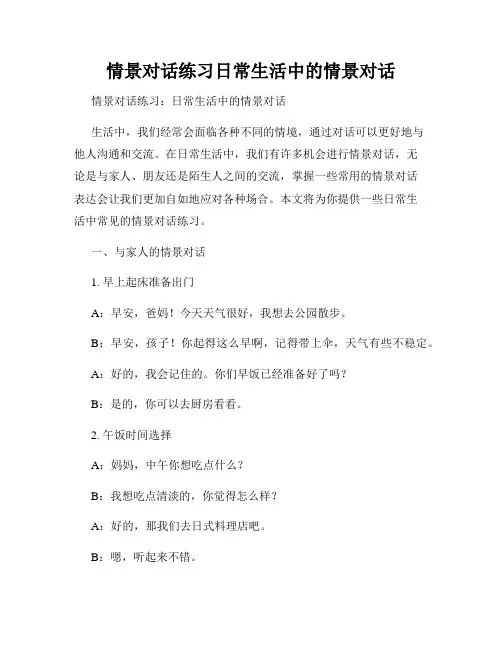
情景对话练习日常生活中的情景对话情景对话练习:日常生活中的情景对话生活中,我们经常会面临各种不同的情境,通过对话可以更好地与他人沟通和交流。
在日常生活中,我们有许多机会进行情景对话,无论是与家人、朋友还是陌生人之间的交流,掌握一些常用的情景对话表达会让我们更加自如地应对各种场合。
本文将为你提供一些日常生活中常见的情景对话练习。
一、与家人的情景对话1. 早上起床准备出门A:早安,爸妈!今天天气很好,我想去公园散步。
B:早安,孩子!你起得这么早啊,记得带上伞,天气有些不稳定。
A:好的,我会记住的。
你们早饭已经准备好了吗?B:是的,你可以去厨房看看。
2. 午饭时间选择A:妈妈,中午你想吃点什么?B:我想吃点清淡的,你觉得怎么样?A:好的,那我们去日式料理店吧。
B:嗯,听起来不错。
3. 与兄弟姐妹讨论晚上的活动A:晚上我们可以去看电影,你们有什么想看的吗?B:我想看最新上映的科幻电影,你呢?A:我对喜剧片更感兴趣,不过我们可以看个折中的。
B:好主意,那我们去购买电影票吧。
二、与朋友的情景对话1. 约定出去聚餐A:最近我们很久没有见面了,要不这周末出去聚个餐吧?B:好主意!你有什么地方推荐吗?A:我听说新开了一家意大利餐厅,口碑不错,我们可以去尝试一下。
B:太好了,我很期待。
2. 打电话确认见面时间A:你好,我是A,请问你今晚有空吗?B:是A吗?我正准备出门,你有什么事情?A:我想跟你约定一下见面时间,我们之前说好今天晚上见面的。
B:真对不起,我忘记了,不过我还是有些事情要处理,改天再见面吧。
3. 聊天时询问对方的近况A:最近怎么样?忙吗?B:是的,我最近工作特别忙,但是也蛮有成就感的。
A:听起来不错,你有没有时间休息一下?B:我打算明天休息一天,好好放松一下。
三、与陌生人的情景对话1. 在商场购物时寻求店员的帮助A:你好,请问这件衣服有其他尺码吗?B:您好,我去帮您查一下库存。
A:谢谢,麻烦你了。
B:没问题,我这就去给您查一下。
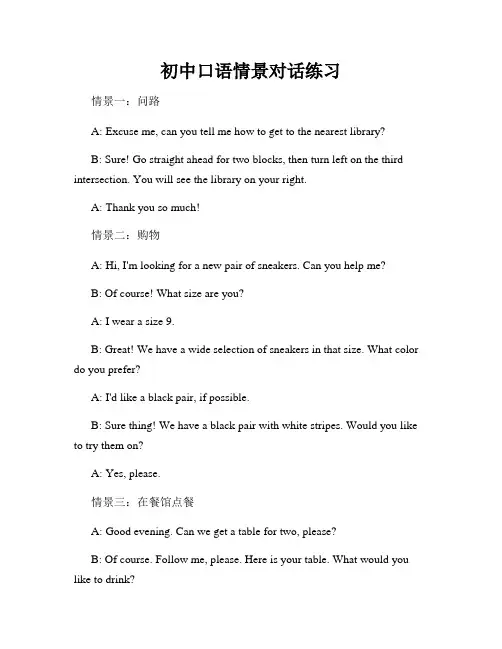
初中口语情景对话练习情景一:问路A: Excuse me, can you tell me how to get to the nearest library?B: Sure! Go straight ahead for two blocks, then turn left on the third intersection. You will see the library on your right.A: Thank you so much!情景二:购物A: Hi, I'm looking for a new pair of sneakers. Can you help me?B: Of course! What size are you?A: I wear a size 9.B: Great! We have a wide selection of sneakers in that size. What color do you prefer?A: I'd like a black pair, if possible.B: Sure thing! We have a black pair with white stripes. Would you like to try them on?A: Yes, please.情景三:在餐馆点餐A: Good evening. Can we get a table for two, please?B: Of course. Follow me, please. Here is your table. What would you like to drink?A: I'll have a cola, please.B: And for you?C: I would like a glass of water, please.B: Alright. Let me get your drinks first, and I'll be back shortly to take your food order.情景四:约朋友出去玩A: Hey, do you want to hang out this Saturday?B: Sure! What do you have in mind?A: I was thinking of going to the park and having a picnic. What do you think?B: That sounds like a great idea! What time should we meet?A: How about we meet at 11 am at the park entrance?B: Sounds good to me. See you then!情景五:询问天气A: Do you know what the weather will be like tomorrow?B: Let me check the forecast for you. It says it will be partly cloudy with a chance of rain in the afternoon.A: Thank you for checking. I guess I'll need an umbrella tomorrow.B: That would be a good idea. Better to be prepared!情景六:在家做作业A: How's your homework coming along?B: I'm having some trouble with this math problem. I don't understand how to solve it.A: Let me take a look. Ah, I see what the issue is. You made a small mistake in your calculation.B: Oh, I didn't notice that. Thank you for pointing it out.A: No problem. I'm here to help. Let's go through the steps together.情景七:道歉A: I'm really sorry for breaking your vase. It was an accident.B: Oh no, that was an antique vase. I can't replace it.A: I know it's irreplaceable, and I feel terrible about it. Is there anything I can do to make it up to you?B: Well, since you're genuinely sorry, maybe you could help me find a similar vase as a replacement.A: That sounds fair. I'll do my best to find one that matches the style.情景八:询问课程安排A: Excuse me, can you tell me the schedule for tomorrow's classes?B: Sure, let me check. In the morning, you have English and Math. After lunch, you have History and Science.A: What time do the classes start?B: English starts at 8:30 am, Math at 10 am, History at 1:30 pm, and Science at 3 pm.A: Thank you for the information.情景九:在火车站买票A: Excuse me, where can I buy a train ticket?B: The ticket counter is right over there. You can line up to purchase your ticket.A: Thank you. How much does a ticket to Beijing cost?B: Let me check for you. The ticket price is 150 yuan.A: I'd like to buy a round-trip ticket, please.B: Alright. Your total will be 300 yuan. Here is your ticket and change. Enjoy your trip!情景十:问候A: Good morning! How are you today?B: Good morning! I'm doing well, thank you. How about you?A: I'm great, thanks for asking. Have a wonderful day!B: You too!。
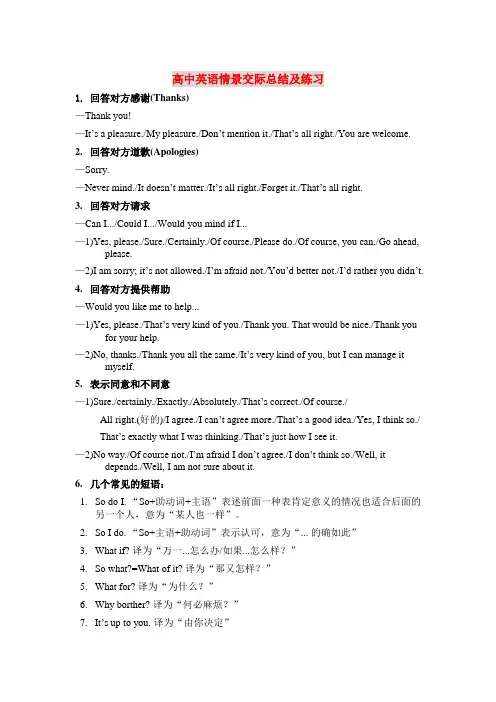
高中英语情景交际总结及练习1.回答对方感谢(Thanks)—Thank you!—It’s a pleasure./My pleasure./Don’t mention it./That’s all right./You are welcome. 2.回答对方道歉(Apologies)—Sorry.—Never mind./It doesn’t matter./It’s all right./Forget it./That’s all right.3.回答对方请求—Can I.../Could I.../Would you mind if I...—1)Yes, please./Sure./Certainly./Of course./Please do./Of course, you can./Go ahead, please.—2)I am sorry; it’s not allowed./I’m afraid not./You’d better not./I’d rather you didn’t.4.回答对方提供帮助—Would you like me to help...—1)Yes, please./That’s very kind of you./Thank you. That would be nice./Thank you for your help.—2)No, thanks./Thank you all the same./It’s very kind of you, but I can manage it myself.5.表示同意和不同意—1)Sure./certainly./Exactly./Absolutely./That’s correct./Of course./All right.(好的)/I agree./I can’t agree more./That’s a good idea./Yes, I think so./ That’s exactly what I was thinking./That’s just how I see it.—2)No way./Of course not./I’m afraid I don’t agree./I don’t think so./Well, it depends./Well, I am not sure about it.6.几个常见的短语:1.So do I. “So+助动词+主语”表述前面一种表肯定意义的情况也适合后面的另一个人,意为“某人也一样”。
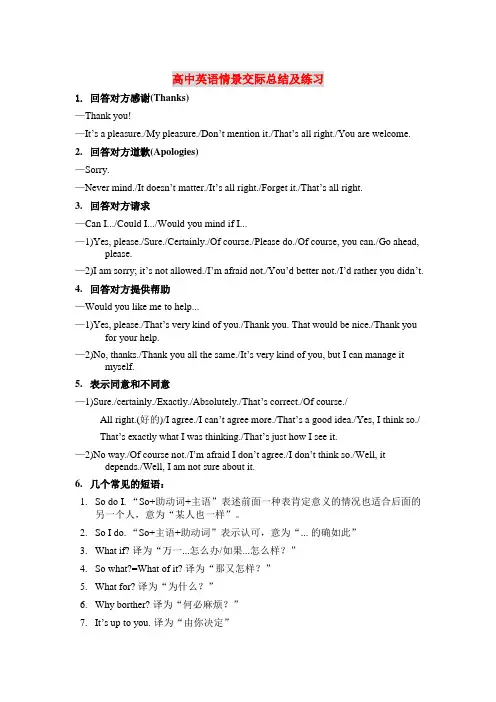
高中英语情景交际总结及练习1.回答对方感谢(Thanks)—Thank you!—It’s a pleasure./My pleasure./Don’t mention it./That’s all right./You are welcome. 2.回答对方道歉(Apologies)—Sorry.—Never mind./It doesn’t matter./It’s all right./Forget it./That’s all right.3.回答对方请求—Can I.../Could I.../Would you mind if I...—1)Yes, please./Sure./Certainly./Of course./Please do./Of course, you can./Go ahead, please.—2)I am sorry; it’s not allowed./I’m afraid not./You’d better not./I’d rather you didn’t.4.回答对方提供帮助—Would you like me to help...—1)Yes, please./That’s very kind of you./Thank you. That would be nice./Thank you for your help.—2)No, thanks./Thank you all the same./It’s very kind of you, but I can manage it myself.5.表示同意和不同意—1)Sure./certainly./Exactly./Absolutely./That’s correct./Of course./All right.(好的)/I agree./I can’t agree more./That’s a good idea./Yes, I think so./ That’s exactly what I was thinking./That’s just how I see it.—2)No way./Of course not./I’m afraid I don’t agree./I don’t think so./Well, it depends./Well, I am not sure about it.6.几个常见的短语:1.So do I. “So+助动词+主语”表述前面一种表肯定意义的情况也适合后面的另一个人,意为“某人也一样”。
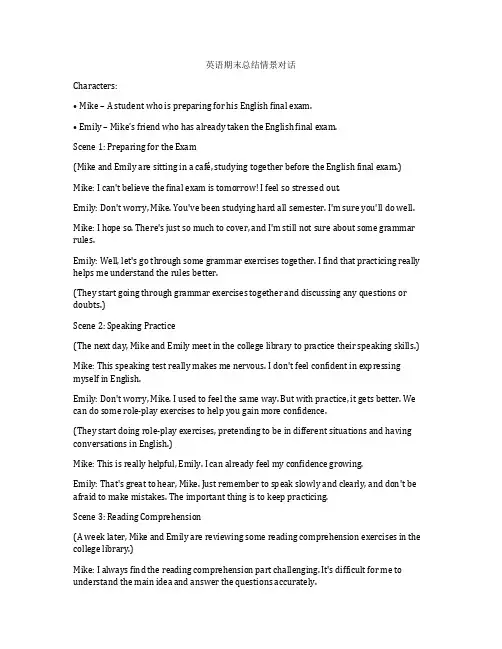
英语期末总结情景对话Characters:• Mike – A student who is preparing for his English final exam.• Emily –Mike’s friend who has already taken the English final exam.Scene 1: Preparing for the Exam(Mike and Emily are sitting in a café, studying together before the English final exam.) Mike: I can't believe the final exam is tomorrow! I feel so stressed out.Emily: Don't worry, Mike. You've been studying hard all semester. I'm sure you'll do well. Mike: I hope so. There's just so much to cover, and I'm still not sure about some grammar rules.Emily: Well, let's go through some grammar exercises together. I find that practicing really helps me understand the rules better.(They start going through grammar exercises together and discussing any questions or doubts.)Scene 2: Speaking Practice(The next day, Mike and Emily meet in the college library to practice their speaking skills.) Mike: This speaking test really makes me nervous. I don't feel confident in expressing myself in English.Emily: Don't worry, Mike. I used to feel the same way. But with practice, it gets better. We can do some role-play exercises to help you gain more confidence.(They start doing role-play exercises, pretending to be in different situations and having conversations in English.)Mike: This is really helpful, Emily. I can already feel my confidence growing.Emily: That's great to hear, Mike. Just remember to speak slowly and clearly, and don't be afraid to make mistakes. The important thing is to keep practicing.Scene 3: Reading Comprehension(A week later, Mike and Emily are reviewing some reading comprehension exercises in the college library.)Mike: I always find the reading comprehension part challenging. It's difficult for me to understand the main idea and answer the questions accurately.Emily: Understanding the main idea is essential, Mike. Let's try reading the passage together and discussing it. This way, we can ensure that we both comprehend it correctly.(They start reading a passage together, stopping to discuss each paragraph and making sure they understand the main points.)Mike: This technique really helps. I can see the improvement in my understanding. Thank you, Emily.Scene 4: Writing Practice(A few days later, Mike and Emily are at Emily's house, practicing their writing skills.) Emily: Writing can be tough, but with enough practice, it becomes easier. Let's start with some essay prompts and work on structuring our essays effectively.Mike: I struggle with organizing my thoughts in a coherent way. Any tips?Emily: First, brainstorm your ideas and create an outline. This will help you see the structure of your essay before you start writing. Then, make sure you use proper paragraphing and transition words to connect your ideas smoothly.(They start writing their essays and then exchange papers to review and provide feedback to each other.)Mike: Your feedback is really helpful, Emily. It makes me more aware of my weaknesses and areas for improvement.Emily: That's what friends are for, Mike. We're here to support each other and help each other grow.Scene 5: Final Exam Results(A few weeks later, Mike and Emily are sitting in the cafeteria, anxiously waiting for the English final exam results.)Emily: I'm sure you did great, Mike. You worked so hard and prepared well for the exam. Mike: I hope so. I still have some doubts about my performance on the writing section. (Instructor approaches them and hands out their exam results.)Instructor: Congratulations, Mike. You scored well on the final exam!Mike: Really? This is such a relief!Emily: I told you, Mike. I had faith in you.(Scene ends with Mike and Emily celebrating their successful completion of the English final exam.)Note: The above dialogue is a summary of different conversations that Mike and Emily would have had over a period of time leading up to the English final exam. The word count is less than 6000 words, but it presents the key conversations and scenes related to their exam preparation and support for each other.。
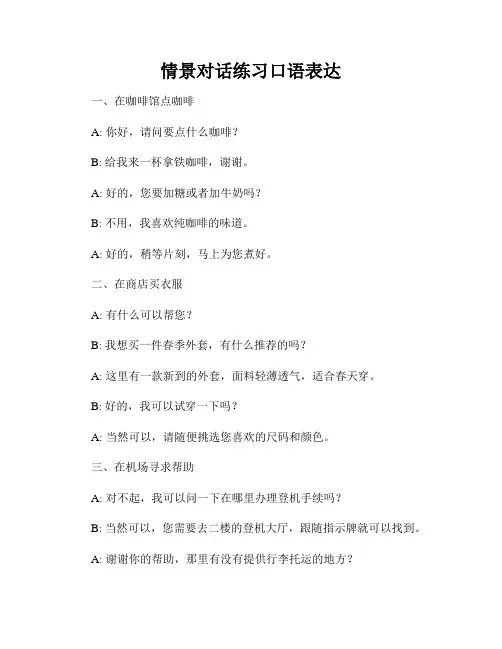
情景对话练习口语表达一、在咖啡馆点咖啡A: 你好,请问要点什么咖啡?B: 给我来一杯拿铁咖啡,谢谢。
A: 好的,您要加糖或者加牛奶吗?B: 不用,我喜欢纯咖啡的味道。
A: 好的,稍等片刻,马上为您煮好。
二、在商店买衣服A: 有什么可以帮您?B: 我想买一件春季外套,有什么推荐的吗?A: 这里有一款新到的外套,面料轻薄透气,适合春天穿。
B: 好的,我可以试穿一下吗?A: 当然可以,请随便挑选您喜欢的尺码和颜色。
三、在机场寻求帮助A: 对不起,我可以问一下在哪里办理登机手续吗?B: 当然可以,您需要去二楼的登机大厅,跟随指示牌就可以找到。
A: 谢谢你的帮助,那里有没有提供行李托运的地方?B: 在登机手续办理完毕后,您可以直接前往安检口旁边的托运柜台。
A: 多谢你的指引,我现在明白了。
四、在餐厅点餐A: 欢迎光临,请问几位用餐?B: 我们是四个人,请给我们找一个四人桌,谢谢。
A: 好的,请随我来。
B: 请给我们看一下菜单,你们有哪些特色菜呢?A: 这是我们的特色菜单,这道油炸鳕鱼是我们最受欢迎的菜品之一。
五、在银行办理业务A: 你好,我想开一个新的储蓄账户。
B: 好的,请您填写一下这份开户申请表格。
A: 我填好了,请问还需要提供哪些资料?B: 请准备好您的身份证和一份常住地址证明,我们将为您办理手续。
A: 非常感谢你的帮助。
六、在旅游景点询问路线A: 你好,请问去博物馆怎么走?B: 很简单,您可以一直沿着主街走,然后左拐走两个街区就能看到博物馆了。
A: 谢谢你的指引,我觉得应该不会迷路了。
七、在医院看病A: 你好,请问我应该到哪个科室挂号?B: 请您填写这份病历表格,然后去门诊挂号窗口办理挂号手续。
A: 好的,我马上填好,谢谢你的帮助。
B: 不客气,祝您早日康复。
总结:以上是一些情景对话练习口语表达的例子,包括在咖啡馆点咖啡、在商店买衣服、在机场寻求帮助、在餐厅点餐、在银行办理业务、在旅游景点询问路线以及在医院看病等。
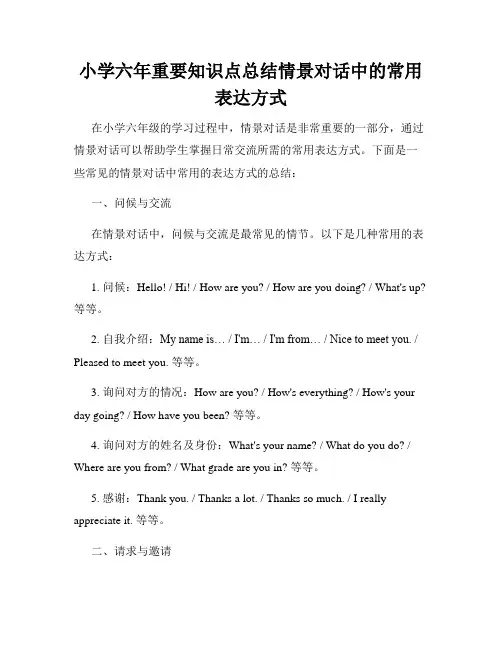
小学六年重要知识点总结情景对话中的常用表达方式在小学六年级的学习过程中,情景对话是非常重要的一部分,通过情景对话可以帮助学生掌握日常交流所需的常用表达方式。
下面是一些常见的情景对话中常用的表达方式的总结:一、问候与交流在情景对话中,问候与交流是最常见的情节。
以下是几种常用的表达方式:1. 问候:Hello! / Hi! / How are you? / How are you doing? / What's up? 等等。
2. 自我介绍:My name is… / I'm… / I'm from… / Nice to meet you. / Pleased to meet you. 等等。
3. 询问对方的情况:How are you? / How's everything? / How's your day going? / How have you been? 等等。
4. 询问对方的姓名及身份:What's your name? / What do you do? / Where are you from? / What grade are you in? 等等。
5. 感谢:Thank you. / Thanks a lot. / Thanks so much. / I really appreciate it. 等等。
二、请求与邀请在情景对话中,请求与邀请也是常见的表达方式。
以下是几种常用的表达方式:1. 请求帮助:Could you please help me...? / Can you help me...? / Would you mind helping me...? 等等。
2. 请求允许:Can I...? / May I...? 等等。
3. 请求借用物品或使用场地:Can I borrow your...? / May I use your...? 等等。
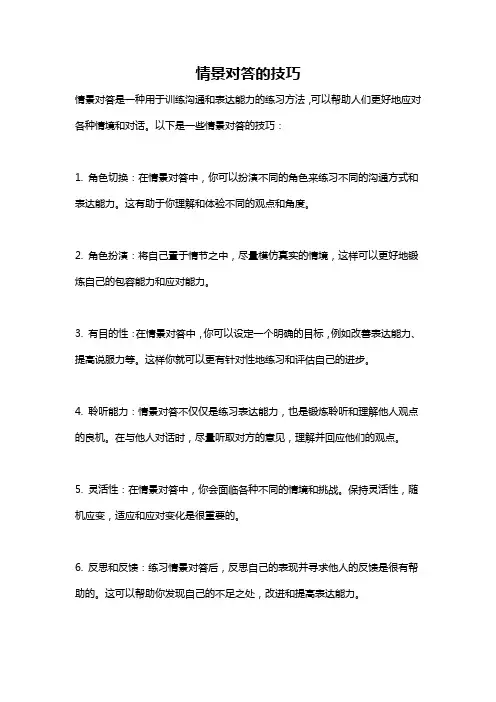
情景对答的技巧
情景对答是一种用于训练沟通和表达能力的练习方法,可以帮助人们更好地应对各种情境和对话。
以下是一些情景对答的技巧:
1. 角色切换:在情景对答中,你可以扮演不同的角色来练习不同的沟通方式和表达能力。
这有助于你理解和体验不同的观点和角度。
2. 角色扮演:将自己置于情节之中,尽量模仿真实的情境,这样可以更好地锻炼自己的包容能力和应对能力。
3. 有目的性:在情景对答中,你可以设定一个明确的目标,例如改善表达能力、提高说服力等。
这样你就可以更有针对性地练习和评估自己的进步。
4. 聆听能力:情景对答不仅仅是练习表达能力,也是锻炼聆听和理解他人观点的良机。
在与他人对话时,尽量听取对方的意见,理解并回应他们的观点。
5. 灵活性:在情景对答中,你会面临各种不同的情境和挑战。
保持灵活性,随机应变,适应和应对变化是很重要的。
6. 反思和反馈:练习情景对答后,反思自己的表现并寻求他人的反馈是很有帮助的。
这可以帮助你发现自己的不足之处,改进和提高表达能力。
7. 练习和实践:情景对答是一个可以长期进行的练习过程。
通过不断练习和实践,你可以逐渐提高自己的互动和沟通能力。
总体来说,情景对答需要练习者保持积极的态度和开放的心态,不断学习和改进自己的表达和沟通能力。
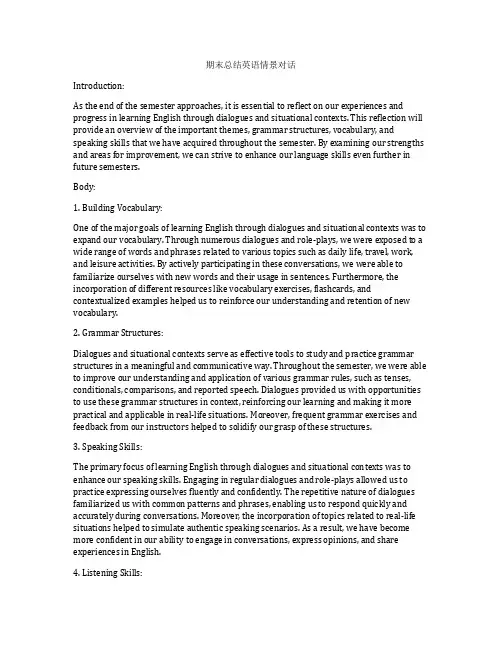
期末总结英语情景对话Introduction:As the end of the semester approaches, it is essential to reflect on our experiences and progress in learning English through dialogues and situational contexts. This reflection will provide an overview of the important themes, grammar structures, vocabulary, and speaking skills that we have acquired throughout the semester. By examining our strengths and areas for improvement, we can strive to enhance our language skills even further in future semesters.Body:1. Building Vocabulary:One of the major goals of learning English through dialogues and situational contexts was to expand our vocabulary. Through numerous dialogues and role-plays, we were exposed to a wide range of words and phrases related to various topics such as daily life, travel, work, and leisure activities. By actively participating in these conversations, we were able to familiarize ourselves with new words and their usage in sentences. Furthermore, the incorporation of different resources like vocabulary exercises, flashcards, and contextualized examples helped us to reinforce our understanding and retention of new vocabulary.2. Grammar Structures:Dialogues and situational contexts serve as effective tools to study and practice grammar structures in a meaningful and communicative way. Throughout the semester, we were able to improve our understanding and application of various grammar rules, such as tenses, conditionals, comparisons, and reported speech. Dialogues provided us with opportunities to use these grammar structures in context, reinforcing our learning and making it more practical and applicable in real-life situations. Moreover, frequent grammar exercises and feedback from our instructors helped to solidify our grasp of these structures.3. Speaking Skills:The primary focus of learning English through dialogues and situational contexts was to enhance our speaking skills. Engaging in regular dialogues and role-plays allowed us to practice expressing ourselves fluently and confidently. The repetitive nature of dialogues familiarized us with common patterns and phrases, enabling us to respond quickly and accurately during conversations. Moreover, the incorporation of topics related to real-life situations helped to simulate authentic speaking scenarios. As a result, we have become more confident in our ability to engage in conversations, express opinions, and share experiences in English.4. Listening Skills:Effective listening is a crucial component of successful communication. Dialogues and situational contexts provided us with ample opportunities to enhance our listening skills. Through the recorded dialogues, we were exposed to a variety of accents, intonations, and speech patterns. By actively listening and engaging with the dialogues, we improved our ability to understand native speakers and enhanced our comprehension skills. Additionally, the use of listening exercises and activities further strengthened our listening abilities, making us more adept at understanding spoken English in different contexts.5. Cultural Awareness:In addition to language skills, dialogues and situational contexts also promoted cultural awareness. By exploring different topics, scenarios, and roles, we gained insights into the culture, traditions, and customs of English-speaking countries. This allowed us to develop a broader understanding of cultural nuances, enabling us to communicate more effectively and respectfully with individuals from diverse backgrounds. Furthermore, cultural discussions provided opportunities for us to appreciate and learn from one another's experiences and perspectives.Conclusion:In conclusion, learning English through dialogues and situational contexts has been an enriching and rewarding experience. The use of dialogues helped us build vocabulary, practice grammar structures, enhance speaking and listening skills, and foster cultural awareness. By reflecting on our strengths and areas for improvement, we can continue to develop our language skills in future semesters. As we move forward, it is essential to acknowledge the value of dialogues and situational contexts as effective tools for learning and to embrace every opportunity to communicate and engage with the English language.。
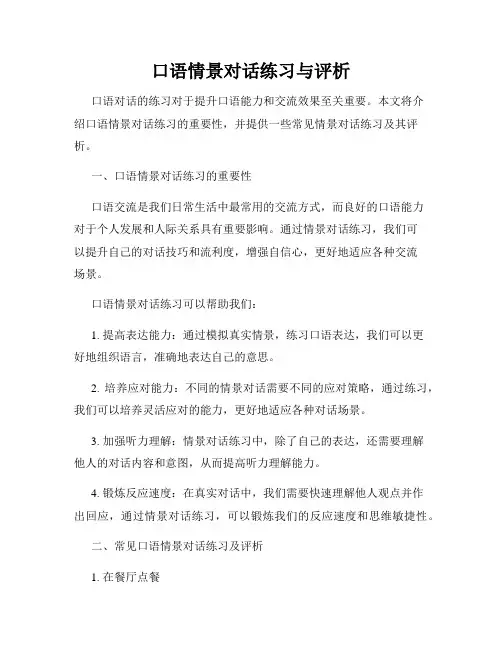
口语情景对话练习与评析口语对话的练习对于提升口语能力和交流效果至关重要。
本文将介绍口语情景对话练习的重要性,并提供一些常见情景对话练习及其评析。
一、口语情景对话练习的重要性口语交流是我们日常生活中最常用的交流方式,而良好的口语能力对于个人发展和人际关系具有重要影响。
通过情景对话练习,我们可以提升自己的对话技巧和流利度,增强自信心,更好地适应各种交流场景。
口语情景对话练习可以帮助我们:1. 提高表达能力:通过模拟真实情景,练习口语表达,我们可以更好地组织语言,准确地表达自己的意思。
2. 培养应对能力:不同的情景对话需要不同的应对策略,通过练习,我们可以培养灵活应对的能力,更好地适应各种对话场景。
3. 加强听力理解:情景对话练习中,除了自己的表达,还需要理解他人的对话内容和意图,从而提高听力理解能力。
4. 锻炼反应速度:在真实对话中,我们需要快速理解他人观点并作出回应,通过情景对话练习,可以锻炼我们的反应速度和思维敏捷性。
二、常见口语情景对话练习及评析1. 在餐厅点餐A: 你好,请问有什么可以帮助您?B: 我想点菜。
A: 好的,请问您需要点什么菜?B: 我要一份糖醋鱼和一个番茄炒蛋。
A: 好的,稍等一下,马上为您上菜。
评析:这个对话情景模拟了在餐厅里点餐的场景。
对话中,B清晰地表达了自己的需求,而A也使用礼貌用语进行回应。
这种情景对话练习可以提高对话中的表达和理解能力。
2. 在火车站咨询A: 请问这趟列车去北京吗?B: 是的,这是去北京的列车。
A: 请问还有剩余的座位吗?B: 只有几张硬座和站票了。
A: 那我要一张硬座票,请帮我订一下。
评析:这个对话情景设定在火车站咨询窗口,A询问了列车的目的地和座位情况,B给予了明确的回答和建议。
这种对话练习可以帮助练习者在咨询场景中准确表达需求和理解对方信息。
3. 在超市购物A: 哎呀,我把钱包忘在家里了。
B: 没关系,你可以用手机支付。
A: 是吗?那太好了!我试试看。
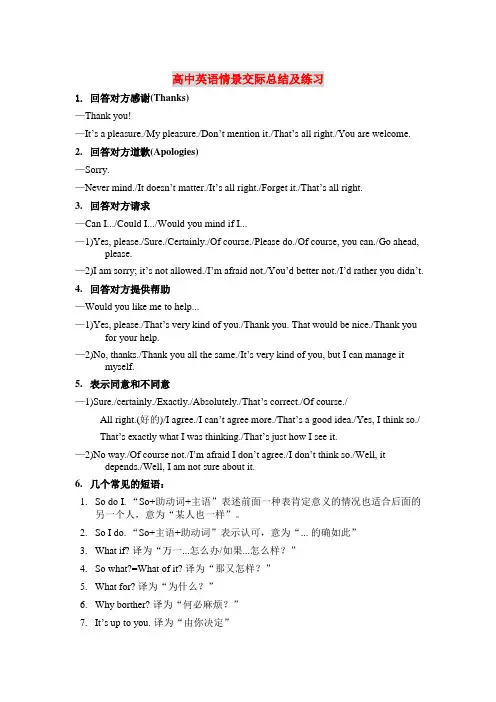
高中英语情景交际总结及练习1.回答对方感谢(Thanks)—Thank you!—It’s a pleasure./My pleasure./Don’t mention it./That’s all right./You are welcome. 2.回答对方道歉(Apologies)—Sorry.—Never mind./It doesn’t matter./It’s all right./Forget it./That’s all right.3.回答对方请求—Can I.../Could I.../Would you mind if I...—1)Yes, please./Sure./Certainly./Of course./Please do./Of course, you can./Go ahead, please.—2)I am sorry; it’s not allowed./I’m afraid not./You’d better not./I’d rather you didn’t.4.回答对方提供帮助—Would you like me to help...—1)Yes, please./That’s very kind of you./Thank you. That would be nice./Thank you for your help.—2)No, thanks./Thank you all the same./It’s very kind of you, but I can manage it myself.5.表示同意和不同意—1)Sure./certainly./Exactly./Absolutely./That’s correct./Of course./All right.(好的)/I agree./I can’t agree more./That’s a good idea./Yes, I think so./ That’s exactly what I was thinking./That’s just how I see it.—2)No way./Of course not./I’m afraid I don’t agree./I don’t think so./Well, it depends./Well, I am not sure about it.6.几个常见的短语:1.So do I. “So+助动词+主语”表述前面一种表肯定意义的情况也适合后面的另一个人,意为“某人也一样”。
提高口语表达能力情景演练对话练习题及答案提高口语表达能力情景演练对话练习题及解析一、购物对话A: 欢迎光临我们的服装店!您需要些什么吗?B: 我想买一件夏季的短袖衬衫。
A: 好的,我们这边有多种样式和颜色的短袖衬衫,请随便挑选。
B: 谢谢!我想要一件蓝色的衬衫,请问有没有我的尺码?A: 当然有,请跟我来。
这是您的尺码,请试穿一下看看如何?B: 好的,让我试试看。
哇,这件衬衫很合身,我喜欢它!A: 很高兴您满意!这件衬衫原价是$50,现在正在打折,只要$30。
B: 太棒了!我买下了。
分析:这段对话是一段典型的购物对话,涵盖了顾客询问需求、店员推荐产品、试穿、价格等基本内容。
通过模拟真实场景,帮助学生在理解相关词汇的同时提升口语表达能力。
二、旅行对话A: 你好!我在计划去旅游,听说你去过许多地方,有什么推荐吗?B: 当然!如果你喜欢自然风光,我推荐你去新西兰。
那里的山水非常壮观。
A: 那听起来不错!我也喜欢历史和文化遗址,你有什么建议吗?B: 如果你对古代文明感兴趣,我建议你去埃及。
那里有世界上最著名的金字塔和尼罗河。
A: 好的,我会考虑的。
你有没有其他地方的推荐?B: 如果你想体验不同的文化,我建议你去日本。
那里有着独特的传统,美食也非常丰富。
A: 谢谢你的建议!我会仔细考虑的。
分析:这段对话是一段关于旅行的对话,在讨论旅行的目的地时,提供了不同类型的推荐。
通过对话练习,学生可以学习到相关的地理和文化知识,并提高日常对话中的口语表达能力。
三、餐厅对话A: 欢迎光临!请问您是预约还是现场就餐?B: 我没有预约,但我希望能找到一个座位。
A: 好的,请跟我来,这边有一张桌子,您觉得怎么样?B: 可以的,谢谢!请给我一份菜单。
A: 当然,请稍等片刻。
这是我们的菜单,请慢慢挑选。
B: 好的,我想要一份牛排和一杯红酒。
A: 好的,我们会尽快为您上菜。
分析:这段对话是一段典型的餐厅对话,涵盖了顾客预约与现场就餐、选座、点菜等基本内容。
情景对话练习日常生活中常用的对话长短不一的日常对话是我们日常生活中必不可少的一部分。
通过情景对话的练习,我们可以更好地提高自己的口语表达能力,并更加流利地与他人交流。
本文将通过一系列示例帮助读者学习和掌握日常生活中的常用对话。
一、打招呼和自我介绍在日常生活中,打招呼和自我介绍是经常遇到的场景。
以下是一些典型的对话示例:A: 早上好!你好吗?B: 早上好!我很好,谢谢。
你呢?A: 我也很好,谢谢。
A: 你好,请问你是新来的吗?B: 是的,我是新来的。
我叫李华,很高兴认识你。
A: 很高兴认识你,李华。
我叫张明。
二、问路和指路在陌生环境中,问路和指路是一项非常必要的技能。
以下是一些常见的对话示例:A: 不好意思,请问这附近有个银行吗?B: 当然有,银行就在前面,沿着这条街一直走,你就会看到了。
A: 非常感谢你的帮助。
A: 对不起,我迷路了。
请问去火车站怎么走?B: 没问题,火车站离这里不远。
你可以沿着这条路一直走,然后左转,火车站就在那里。
A: 谢谢你的指路。
三、订餐和点菜在餐厅用餐时,我们需要与服务员进行简单的对话,以订购我们想要的食物。
以下是一些常见的对话示例:A: 你好,请给我们两个菜单。
B: 好的,请稍等一下。
A: 服务员,我想要一份牛肉面和一杯橙汁。
B: 好的,稍等一下,我马上为您上菜。
四、购物和支付购物是我们日常生活中重要的一部分。
以下是一些常见的购物对话示例:A: 你好,请问这件衬衫多少钱?B: 这件衬衫打折后是200元。
A: 好的,我要买下它。
A: 对不起,我在这个商场看中了一件裙子,但是我不确定要不要买。
B: 没问题,您可以试穿一下。
如果合适,您可以决定是否购买。
五、约会和活动安排在日常生活中,我们常常需要和朋友或家人约定时间和地点进行各种活动。
以下是一些常见的对话示例:A: 明天晚上你有空吗?要不要一起去电影院看电影?B: 当然可以。
你觉得几点合适?A: 我们可以在7点半在电影院门口见面。
高中英语情景交际总结及练习1.回答对方感谢(Thanks)—Thank you!—It’s a pleasure./My pleasure./Don’t mention it./That’s all right./You are welcome. 2.回答对方道歉(Apologies)—Sorry.—Never mind./It doesn’t matter./It’s all right./Forget it./That’s all right.3.回答对方请求—Can I.../Could I.../Would you mind if I...—1)Yes, please./Sure./Certainly./Of course./Please do./Of course, you can./Go ahead, please.—2)I am sorry; it’s not allowed./I’m afraid not./You’d better not./I’d rather you didn’t.4.回答对方提供帮助—Would you like me to help...—1)Yes, please./That’s very kind of you./Thank you. That would be nice./Thank you for your help.—2)No, thanks./Thank you all the same./It’s very kind of you, but I can manage it myself.5.表示同意和不同意—1)Sure./certainly./Exactly./Absolutely./That’s correct./Of course./All right.(好的)/I agree./I can’t agree more./That’s a good idea./Yes, I think so./ That’s exactly what I was thinking./That’s just how I see it.—2)No way./Of course not./I’m afraid I don’t agree./I don’t think so./Well, it depends./Well, I am not sure about it.6.几个常见的短语:1.So do I. “So+助动词+主语”表述前面一种表肯定意义的情况也适合后面的另一个人,意为“某人也一样”。
高中英语情景交际总结及练习1.回答对方感谢(Thanks)—Thank you!—It’s a pleasure./My pleasure./Don’t mention it./That’s all right./You are welcome. 2.回答对方道歉(Apologies)—Sorry.—Never mind./It doesn’t matter./It’s all right./Forget it./That’s all right.3.回答对方请求—Can I.../Could I.../Would you mind if I...—1)Yes, please./Sure./Certainly./Of course./Please do./Of course, you can./Go ahead, please.—2)I am sorry; it’s not allowed./I’m afraid not./You’d better not./I’d rather you didn’t.4.回答对方提供帮助—Would you like me to help...—1)Yes, please./That’s very kind of you./Thank you. That would be nice./Thank you for your help.—2)No, thanks./Thank you all the same./It’s very kind of you, but I can manage it myself.5.表示同意和不同意—1)Sure./certainly./Exactly./Absolutely./That’s correct./Of course./All right.(好的)/I agree./I can’t agree more./That’s a good idea./Yes, I think so./ That’s exactly what I was thinking./That’s just how I see it.—2)No way./Of course not./I’m afraid I don’t agree./I don’t think so./Well, it depends./Well, I am not sure about it.6.几个常见的短语:1.So do I. “So+助动词+主语”表述前面一种表肯定意义的情况也适合后面的另一个人,意为“某人也一样”。
情景对话练习总结
-标准化文件发布号:(9556-EUATWK-MWUB-WUNN-INNUL-DDQTY-KII
2
【每日一题】情景对话-购物篇1
Please choose a wrong one.(选择一个不恰当的)
——__________________请问需要什么帮助吗
—— I want a pair of new shoes.
A.Can I help you
B.What can I do for you?
C.What can I do?
D.What do you want
今天答案要选【C.What can I do】,AB选项毫无疑问,是正确且常用的说法。
我们在平时买东西的时候呢,常会说I want ……,那么D选项的说法就是可以
的,外国人可以懂你的意思,那么他那样说你也可以理解,只是这样说并不是
很客气。而C选项在口语里面,单说这句话有“你要我怎么办呢我还能怎么办
呢”在购物时说这句话的比较少,一般会在后面加一个“for you”。
【每日一题】情景对话-购物篇2
Please choose a right one.(选择一个正确的)
——_______________(能给我大一号的吗)
——Sure.
A.Can I have a size larger.
B.It's too small.
C.I want a big one.
D.Could you change one
今天的答案是【A.Can I have a size larger】B选项是“这个太小了”,但是没有表
达出我想要另外大一号的;C选项是“我要一个大的”,没有体现是比现在的大
一号;D选项是“你能给我换一个吗”,所以我们选择A。
【每日一题】情景对话-购物篇3
Please choose a right one.(选择一个正确的)
——___________________(我能用这张信用卡付款吗)
——Sure.
A.This credit card.
B.Can I pay by this credit card?
C.Can I pay by cash?
D.Can I use card?
今天的题目选择是【B:Can I pay by this credit card】A选项是“这张卡”,C选
项是“我能用现金支付吗”,D选项是“我能用卡吗”,所以我们选择B。
【每日一题】情景对话-购物篇4
Please choose a right one.(选择一个正确的)
——___________________(多久能运到)
——About one week.
A.How long does it take for delivery(运送)
B.How long will you send?
C.When will you send?
D.What time will you send?
今天的题目选择是【A:How much does it take for delivery】
B选项是“你多久能发货的意思”,CD选项是“你什么时候发货”
,所以我们选择A。
这道题需要注意的是问时间的疑问代词的区别:how long(问时间段,
“多久”的意思; what time=when,“什么时候”的意思
【每日一题】情景对话-购物篇5
Please choose a Wrong one.(选择一个不恰当的)
——___________________!(太贵了啊!)
A.That's too expensive(昂贵的).
B.That's too much for my blood(血).
C.Can you make it cheaper(更便宜)
D.You are kidding me,that's too much.
周五的题目选择是【C:Can you make it cheaper】C选项是“你能便宜点儿吗”
并没有直接表达很贵,而且他几个A选项就是最直接的“太贵了!”;B选项是
一种特殊说法,blood是血的意思,其实我们常说的血拼啥的就有这方面意
思,这句话其实是“要放我太多的血了”也是指很贵;D选项“你开玩笑吗太贵
了!”,所以我们选择C。
【每日一题】情景对话-酒店入住篇1
Please choose a Right one.(选择一个正确的)
——Good afternoon,welcome to A hotel ! Can I help you,sir?
——___________________.(我要办理入住!)
A.I want to live in.
B.I would like to check-in.
C.I need a room.
D.I want to buy a room.
今天的题目选择是【B:I would like to check-in.】"check in"表示的是办理入住
也可以在机场换取登机牌的时候说,“check out”表示的是退房,所以B是最准
确的。A和C这样讲呢,外国人是可以大致懂得你的含义,但是因为入住有专
门的说法,所以这两种不是最准确的,而D选项是“我要买一个房间”和实际含
义差的更大一些。
【每日一题】情景对话-酒店入住篇2
Please choose a Right one.(选择一个最准确的)
——___________________(这个价格含早餐吗)
A.Can I eat breakfast?
B.Is there a breakfast?
C.Does the price including(包含) breakfast?
D.Breakfast in
今天的题目选择是【C:Does the price including breakfast】"including"表示的是
包含的意思,所以C选项是最准确的。A“我能吃早餐吗”;B“这有早餐吗”;D
选项是一种表达的错误,"in"表示"在…“的里面,指的是方位。所以选择C。
【每日一题】情景对话-酒店入住篇3
Please choose a Right one.(选择一个最准确的)
——___________________.(我需要一个标准间.)
A.I want a single(单独的) room.
B.I want a double(双倍的) room.
C.I want a twin(两个的) room.
D.I want a triple room.
今天的题目选择是【C:twin room】A "single room"表示的是单人间;B"double
room"是双人间,但是是指有一张双人床的房间;C"twin room"就是标准间;D
“triple room”是三人间。大家要记住哦,以后出国玩订酒店选房间就不会错啦~
~~